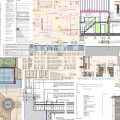Budget priorities
Good architecture provides good value and can be a sound investment. To ensure this is realised, it is important that clients define where their priorities lie: for some, speed is vital and best value may be in achieving a defined completion date; for others, the crucial value may be achieved in making the most productive use of space in and around a Listed Building. Very often there will be several goals in a building project and achieving the best balance between cost, time, quality, environmental performance, space and delight is a vital part of good architecture and crucially involves clients and architect throughout the progress of the job.
Factors Affecting Cost
Your architect will advise you on the many factors which affect the ultimate cost of a project; these may include the construction method, the geographical location, how much you do yourself, the shape, size and complexity of a building, the materials and design, the quality of construction and specific site conditions. There may also be costs associated with land purchase, and borrowing costs. Difficulties in obtaining consents and sometimes onerous conditions attached to a permission may pressurise the budget further.
Cost Estimating and Management
Successful cost estimating and cost management are difficult and demanding which means that due care and attention need to be paid to them throughout. In the early stages of preparing a brief for the project, it is important for clients to define their project budget and to include for all likely fees, for VAT where applicable, and for appropriate contingencies.
For smaller projects under £1M, architects typically advise clients of likely costs during the design stage and during work on site they can provide cost advice, valuation of work in progress for monthly certificates, and negotiation of the final account with the contractor. See below for larger projects and other consultants.
Estimating in the design stages is a series of “best guesses” based on recent experience of similar work; since every project is different and circumstances for each tender process also vary, it is not possible to predict project costs with certainty.
Architects’ Fees
Architects’ fees reflect the size and complexity of a project and method of procurement. For example, a simple new house on a clear flat site with a traditional contract may have a fee of around 8%; refurbishment/extensions 10-12.5%; whereas complex work to historic buildings may have a fee range of 15-20%. Design and build projects attract a lesser fee as the architect may not be involved in detailed design. Fees would be reduced on larger scale projects or those which include repetition. Architects often base fees on an estimate of time required to complete the work rather than percentages which can prove fairer for both client and architect.
Other Fees and Charges
The list below identifies possible other consultants, some or all of whom may be required by planners for particular projects. On a simple project, only the architect and structural engineer may be appointed.
- Architect
- Structural engineer
- Planning consultant
- Landscape architect
- Quantity surveyor
- Land and buildings surveyor
- Party wall surveyor
- Historic building consultant
- Archaeologist
- Contaminated land assessor
- Asbestos surveyor
- Ground investigation consultant
- Services Engineer
Ecologist/Arboriculturalist - Flood risk assessor
- Highways/traffic consultant
SAP/BREAM assessor - Passivhaus Certifier
- Acoustic consultant
Fees from all the above will be subject to VAT.
Planning application fees are payable directly to local authority and are not subject to VAT. As yet, no fees are charged for Listed Building applications, though preliminary advice for both services may be chargeable and is subject to VAT. Some types of projects or clients are exempt from planning fees.
Building regulations applications can be made to the local authority or private approved inspectors and fees are subject to VAT. The amount depends on the type and scale of the project, some types of projects or clients are exempt from fees.
Contingencies
A contingency budget is a sum of money intended to provide for unforeseen work: for example tricky ground conditions, dealing with an existing building, unusually adverse weather etc.
Construction cost contingencies for new build projects are often advised as 5% and for existing building projects at 10%. Setting contingencies typically varies with the complexity, information and stage of projects: more complex projects have a higher risk of unanticipated events and delays; scanty information requires allowance for dealing with the unknown; at the earliest stages of design, a project brief is unlikely to be fully defined – conversely, once construction nears completion, the risks of the unexpected tend to diminish, so contingencies are often progressively reduced.
Quantity Surveyors
For substantial projects, or where explicitly detailed estimating and cost management are required, Quantity Surveyors provide clients with the necessary specialist advice. For a full service, including a Bill of Quantities where the whole project is measured in detail and tabulated for contractors to price, a QS may typically charge between 1.5 and 7% of the construction cost.
For a smaller scale project, a QS can provide a one off cost plan for a smaller fee which may be beneficial at the early stages to ensure a scheme is affordable. These early budgets prepared by a QS are well worth the effort. They will look at the costs of all elements of the work and can give clarity at a stage where it is easier to make changes to a project and allow you to make informed decisions.
It is cheaper to change a building project whilst it is still on paper!
Budget flexibility
Projects sometimes run into financial difficulty in the later stages when unforeseen costs arise. For example, ground conditions may be extremely challenging so foundations may be more complex. Planning Conditions might be onerous and cause delays or additional work. Statutory services such as drainage, water, gas and electricity may restrict or impede what is planned or may require replacement.
As a result, we believe that there is merit in more design, investigation and budget advice before Planning is submitted to reduce or at least highlight the risks to the Client once Planning is achieved. This process is now formalised on the planning front by ‘Pre-applications’ which are typically submitted as soon as the sketch scheme is agreed: although they delay planning consent (typically by a month), they reduce risk and clarify both the design detail required and whether other inputs are required from ecologists, archaeologists etc.
It is sensible for clients to include within their project brief some element of flexibility, for example in works that may be omitted, delayed or reduced if tenders are received above the budget. Otherwise, it is prudent to allow significant project contingencies.
Long term balance
Last, but not least, consideration should be given to the running costs of a new building. Careful design, detailing and good quality construction of a well-insulated, draught-free building may cost more at the outset, but can offer considerable cost savings during the lifetime of a building. This really matters in the age of rapidly increasing fuel costs. Passivhaus standard construction minimises a building’s energy requirements whilst giving high levels of comfort, so is worth considering if it is appropriate for your building project.



